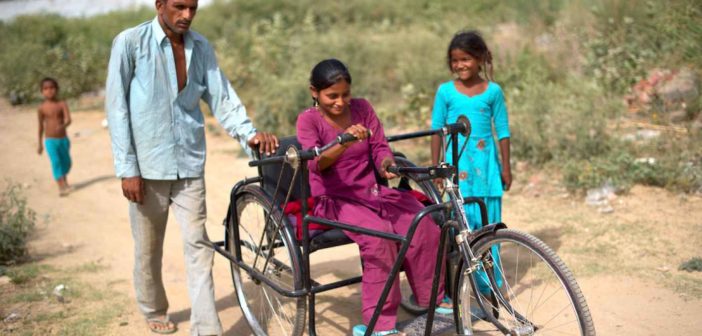According to the 2011 Census, there were 26.8 million persons with disabilities in India, making up 2.21% of the country’s total population. More recent data from the National Sample Survey’s 76th round in 2018 shows that the proportion of people with disabilities has slightly increased over time. Overall, 2.3% of India’s population was reported as having some form of disability. Some states reported more than the national average percentage of PWDs.
Disability comes in many forms, affecting a person’s body, mind, or senses—sometimes in multiple ways. Some people are born with disabilities, while others acquire them later due to illness, injury, or aging. But beyond the condition itself, the real struggle often lies in the barriers society creates—difficulty accessing education, finding jobs, receiving proper healthcare, or simply being included. Deep-rooted stigma can make these challenges even harder, pushing people with disabilities to the margins instead of embracing them as full and equal members of the community. However, measuring disability is not easy because different countries and organizations define it in different ways. These differences come from the various ways people look at and understand disability.
In this two-part series on disabled people in India, we explore the legal and constitutional provisions in place to support people with disabilities, and the statistics on disability in India.
Disability in India
According to the 2011 Census, there were 26.8 million people with disabilities in India, making up 2.21% of the country’s total population. Over the span of a decade, the number of people with disabilities grew from 21.9 million in 2001 to 26.8 million in 2011. Of this group, 56% were men and 44% were women. Nearly 69% of people with disabilities live in rural areas, where access to basic services is even more limited.
Legal and Constitutional provisions for disabled in India
India’s Constitution lays a strong foundation for protecting the rights and dignity of people with disabilities. It promises justice, equality, and freedom for all citizens, ensuring that no one is left behind. Article 41 directs the State to provide education, employment, and support for those facing challenges due to disability, illness, or old age. Article 46 goes further, calling for special care to uplift the weaker sections of society and shield them from injustice. While disability-related welfare falls under the responsibility of individual states, the overarching constitutional vision is clear—building an inclusive society where every individual has the opportunity to thrive.
Over the decades, various governments enacted legislations that govern different aspects of disability, and welfare and empowerment of the persons with disabilities, some of which are below.
- The Mental Health Act, 1987 (Superseded by The Mental Health Care Act, 2017)
- The Rehabilitation Council of India Act, 1992
- Person with Disabilities (Equal Opportunities, Protection of Rights and Full Participation) Act, 1995 (Replaced by the RPWD Act, 2016)
- The National Trust for the Welfare of Persons with Autism, Cerebral Palsy, Mental Retardation and Multiple Disabilities Act, 1999
- National Policy for Persons with Disabilities, 2006
- The Rights of Persons with Disabilities (RPWD) Act, 2016
Statistics on Disability in India
Understanding the scale of disability in India has always been challenging, as societal stigma and inconsistent definitions have made data collection difficult. The first attempt to record disability data in India dates back to the 1872 Census, which included questions on physical and mental infirmities, including leprosy. This continued in successive censuses until 1931, but concerns over data reliability led to its discontinuation in 1941. After a 50-year gap, disability data were reintroduced in the 1981 Census, aligning with the International Year of Disabled Persons. Initially, the scope was limited to three broad categories—total blindness, total deafness, and total physical disability—but expanded in later censuses, including the 2011 Census, which recorded eight types of disabilities.
Alongside the Census, the National Sample Survey (NSS) has played a key role in tracking disability-related trends. The first efforts came in the 15th round (1959-60), followed by the 16th, 24th, and 28th rounds through the 1960s and 1970s. A more structured approach began with the 36th round in 1981, which collected data on the type, cause, and impact of disabilities. The 47th round (1991) and 58th round (2002) further refined this approach, adding mental disabilities to the scope. The most comprehensive effort came in the 76th round (2018), which examined not just prevalence but also access to public spaces, employment, and healthcare.
Building on these surveys, the Ministry of Statistics and Programme Implementation (MoSPI) has published several reports to highlight the status of persons with disabilities in India. The most recent, Persons with Disabilities (Divyangjan) in India – A Statistical Profile: 2021, provides a detailed analysis based on Census 2011 and NSS 76th round data. It covers key aspects such as education, employment, and the economic conditions of persons with disabilities. These reports play a crucial role in shaping policies and ensuring better inclusion, accessibility, and support for people with disabilities in India.
Before looking at the trends, it’s worth noting that recent surveys have expanded the definition of disability. So, any rise in numbers may not necessarily indicate a sharp increase in disabilities, but rather a better recognition and reporting.
Disability in India: 2.2% Affected, Higher in Rural Areas (2.3%) than Urban (2%)
As per Census 2011, around 26.8 million people in India were recorded as living with a disability—that’s about 2.21% of the total population. Of this, 14.9 million were men and 11.9 million were women. Most of them—over 18 million—lived in rural areas, where access to services and support is often limited, while around 8.1 million lived in urban settings.
More recent data from the National Sample Survey’s 76th round in 2018 shows that the proportion of people with disabilities has slightly increased over time. Overall, 2.3% of India’s population was reported as having some form of disability—2.3% in rural areas and 2% in urban areas. Back in 1981 (NSS 36th round), those numbers were lower—1.8% in rural areas and 1.4% in urban areas.
There’s a clear gender gap when it comes to disability in India, with a higher proportion of men living with disabilities compared to women. Over time, this divide has become more noticeable. In rural areas, the share of men with disabilities rose from 2% in the 36th round of the National Sample Survey to 2.6% in the 76th round. For urban men, the numbers increased from 1.5% to 2.1% during the same period.
Among women, the increase has been more modest. In rural areas, disability among women rose from 1.6% to 2%, while in urban areas, it went up from 1.3% to 1.8%. Though the numbers are rising across the board, the gap between men and women remains noticeable, pointing to both biological and social factors that might influence how disability is identified and reported across genders.
Among the different types of disabilities, locomotor issues were the most commonly reported. These include conditions like cerebral palsy, muscular dystrophy, polio, dwarfism, leprosy-cured status, and even injuries from acid attacks. About 1.3% of the rural population and 1.1% of the urban population reported such disabilities, with the national average coming to 1.2%.
Seven States reported Disability Rates above National Average in 76th Round
When it comes to the regional spread of disability in India, some states consistently reported higher numbers than the national average. In the 76th round of the National Sample Survey, the all-India disability rate stood at 2.2%. However, seven major states—Andhra Pradesh, Haryana, Karnataka, Kerala, Odisha, Punjab, and Uttar Pradesh—surpassed this figure. Odisha and Kerala recorded the highest proportions at 3.2%, followed by Andhra Pradesh at 3%, and Punjab and Haryana at 2.7%.
A look back at the 58th round, when the national average was 1.8%, shows a similar trend. Himachal Pradesh topped the list back then with 2.6%, followed by Odisha at 2.5% and Kerala at 2.2%. Interestingly, some states have remained consistently above the national average across survey rounds.
Among the Union Territories, Puducherry stood out in both rounds with a higher-than-average share of people with disabilities, highlighting regional disparities.
In the second part, we look at other characteristics of persons with disabilities including their socio-economic conditions.



